|
|
German Naval Divisions in Flames of War
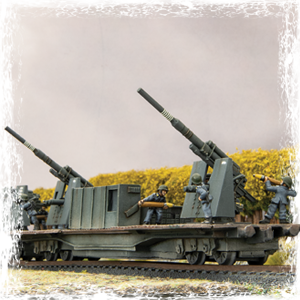 |
German Naval Divisions in Flames of War
With Ryan Jeffares
Berlin German’s release has brought with it several new command cards, and in this article, we’ll examine the history and rules for the Marine-Grenadier Divisions, hastily formed divisions made up of Naval personnel which would fight far more fiercely than might have been expected for an ad-hoc unit.
|
|
By 1945, five years of war had inflicted significant casualties on the German army, which forced the German High Command to seek recruits from outside the civilian manpower pool. The proposed solution was to exploit the surplus manpower of the German Navy, which was now overstaffed and of decreasing relevance as the front was now well within the borders of the Reich. The creation of these divisions was similar to the creation of the Luftwaffe Field Divisions, where excess airmen and ground crews were used as cadres for new divisions. These new Divisions were originally planned to be placed under Heer (Army) control, but at the request of Großadmiral (Grand Admiral) Karl Dönitz, Hitler instead ordered that these men would be formed into Marine infantry divisions under Kriegsmarine (Navy) command.
|
|
At least 5 divisions were formed from Naval personnel, but of these only the 1st and 2nd Divisions saw any significant action, fighting on both the Eastern and Western Fronts. While these Divisions are referred to as ‘Marine’ divisions they were not specialised in naval landings as was the case with the US or Royal Marines but were rather Marine (Naval) troops who had been reformed into ersatz infantry units.
|
|
In terms of organisation, the Marine-Grenadier Divisions were organised in the same manner as the Heer Volksgrenadier Divisions, with three grenadier regiments of two battalions each. Their infantry companies followed the same organisation, with two platoons equipped with StG 44 Assault rifles focused on close-range firepower, with a third platoon armed with K98 rifles and MG42s which would provide covering fire. The soldiers were supplied with a significant number of Panzerfausts and Panzershrecks, which were of increased importance due to the limited number of anti-tank guns each division fielded.
|
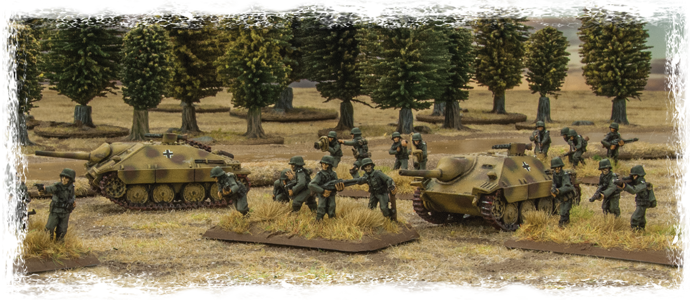 |
|
The 1st Marine-Grenadier Division was formed in February 1945, from the coastal defence units of Marine-Schützen-Brigade Nord (Navy Rifle Brigade North), which were tasked with defending the coast of the North Sea. The Division would take part in the fighting on the Oder against the Soviets from February through to May 1945, being deployed North of Berlin near Stettin. Over the course of March and April, the division would take heavy losses as the Soviets crossed the Oder and fought to expand their bridgeheads, eventually being forced back in a series of rear-guard actions. Disastrously, on 27 April, Soviet forces would breach the division’s defences west of Prenzlau and scatter the division, with individual battlegroups fighting their way to the West in order to surrender to the British. The 2nd Marine-Grenadier Division would initially have little in the way of equipment aside from small arms and panzerfausts, but would eventually receive 7.5cm Pak 40 anti-tank guns and would be joined by Marine-Artillerie-Regiment 1, which was armed with captured Soviet artillery, including 12.2cm howitzers, as well as German guns.
|
|
2nd Marine-Grenadier Division was formed in Schleswig-Holstein during March 1945, using a mixture of excess naval personnel, Hitler Youth, a battalion of Waffen-SS as well as two battalions of Hungarians from artillery and panzer training schools. The division saw combat on the Western front, as part of Army Group Student, trying to prevent the British from crossing the Aller and Weser rivers. It was deployed to cover several key bridges near Verden and rook part in fierce fighting, repeatedly counterattacking to try and reduce British bridgeheads on the Weser. During the fighting, the 2nd Marine-Grenadier Division was supported by the 122. Flakregiment, which was equipped with a variety of anti-aircraft guns, including 8.8cm and 10.5cm guns mounted upon railway cars. These guns would provide the Grenadiers with much-needed firepower, helping to mitigate their shortages of heavy weapons and would prove crucial in holding up the British attack on Rethem.
|
|
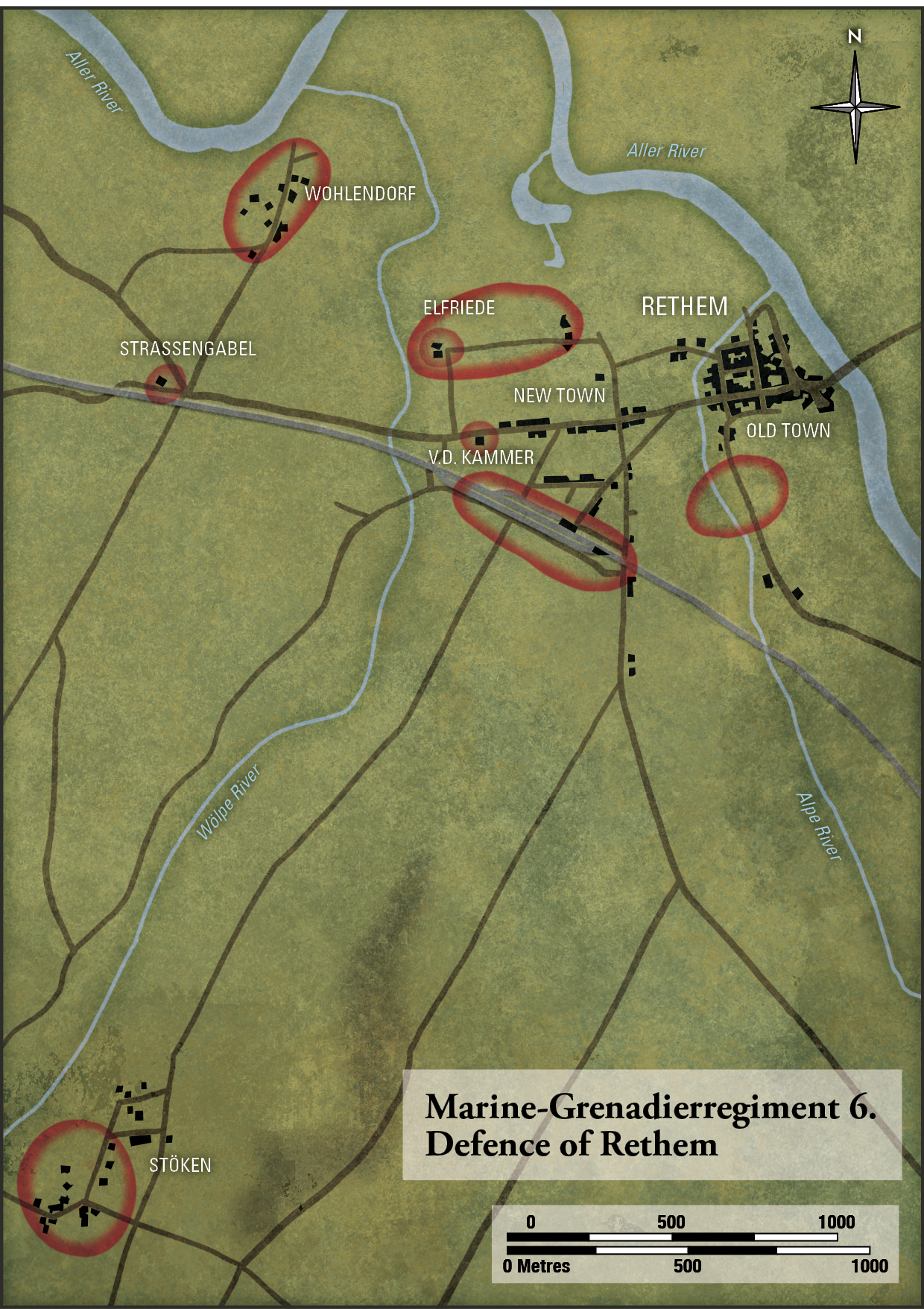
|
|
The other Marine-Grenadier Divisions saw very limited service, but there is no reason why you couldn’t use these command cards to represent them on the battlefield. Finally, a small number of Kriegsmarine units would be flown into Berlin as the Soviets moved to encircle the city and would fight in the subsequent battle alongside the other SS and Heer forces there. You could represent these units by using the Marine Grenadier Division Cards and mixing in support units and other formations from Berlin: German, as these Naval troops weren’t equipped with anything heavier than small arms and Panzerfausts.
|
In Flames of War
|
|
The Marine-Grenadier divisions can be represented on the table by using the 1st & 2nd Marine-Grenadier Divisions card, which provides a new formation diagram.
The formation consists of the following:
|
|
1 Marine-Grenadier Company HQ
1-2 Marine-Grenadier Assault Platoons
1 Marine-Grenadier Rifle Platoon
0-1 Marine-Grenadier sMG42 Machine-gun Platoon
0-1 Marine-Grenadier Mortar Platoon
0-1 Marine-Grenadier 15cm Gun Platoon
or Marine-Grenadier 12cm Mortar Platoon
0-1 Marine-Grenadier Tank-hunting Platoon
or Marine-Grenadier 7.5cm Tank Hunter Platoon
|
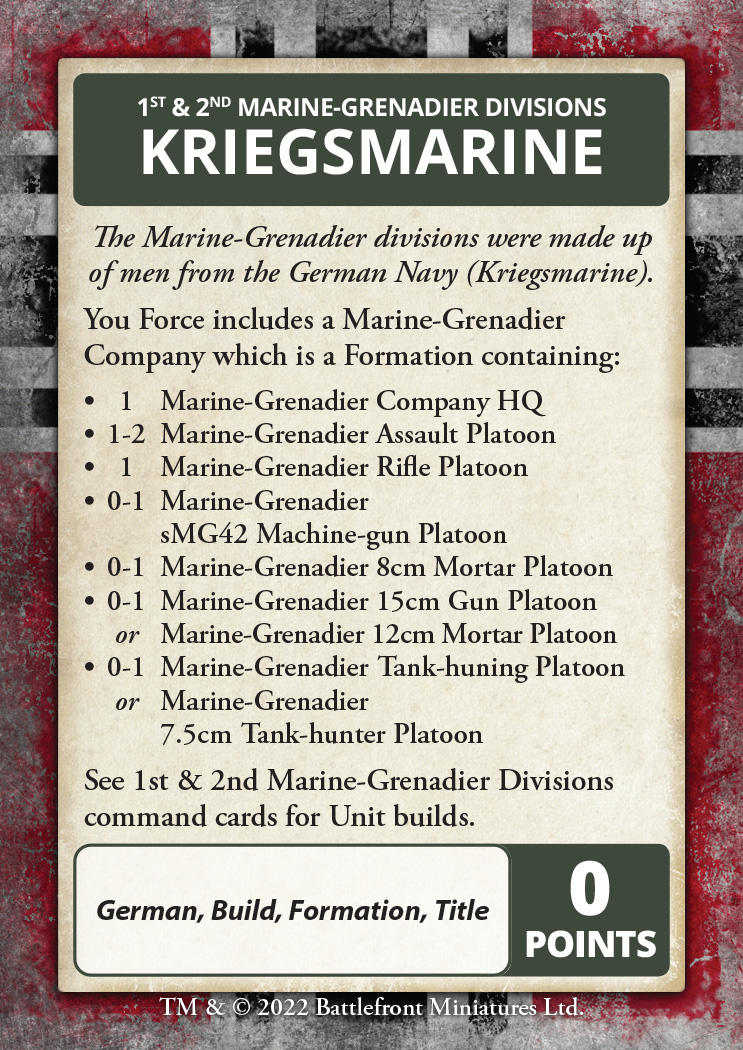 |
|
These units are represented by a further series of Command Cards, which alter the statistics of units from Bulge: German or provide the statistics for an entirely new unit. Furthermore, there are also cards that allow you to field the 10.5cm and 12.2cm artillery guns and Hetzer tank hunters which were attached to these divisions as support platoons.
|
|
Compared to Volksgrenadiers, the Marine-Grenadiers have an improved motivation of Fearless 3+, though they lose the Third Reich rule. The improved morale of the Marine Grenadiers will make them much more likely to stick around as they take casualties, whilst also making them more likely to unpin and counterattack in assaults. This helps mitigate one of the key weaknesses of Volksgrenadiers, which usually have difficulty getting the best out of their excellent weaponry due to their poor unit ratings. Your company commander will also be particularly useful as his reroll on motivation checks will help ensure your units stick around to the last man on that crucial objective or counterattack in a pivotal assault.
|
|
The Tank-Hunting platoon is an interesting choice as it is well-supplied with high AT weapons, making it an incredibly hard unit for enemy tanks to assault, though it lacks anti-infantry firepower. However, if supported by a platoon of machine guns or light anti-aircraft guns, they should be capable of holding down an objective against most foes. The improved morale of the Marines also benefits their mortars and artillery, which become much more likely to unpin, enabling them to perform better in an artillery duel than their Volksgrenadier counterparts, which is crucial in mitigating the damage enemy artillery can inflict on your infantry platoons.
|
|
The option offered by the Captured Guns command card is more of a flavourful historical choice, as they trade access to smoke for a slightly longer range compared to the German 10.5cm howitzers. However, you have other options for smoke such as 8cm mortars or other German artillery, so I wouldn’t discount these guns immediately, besides I’m sure 12.2cm howitzers would look great in dunkelgelb!
|
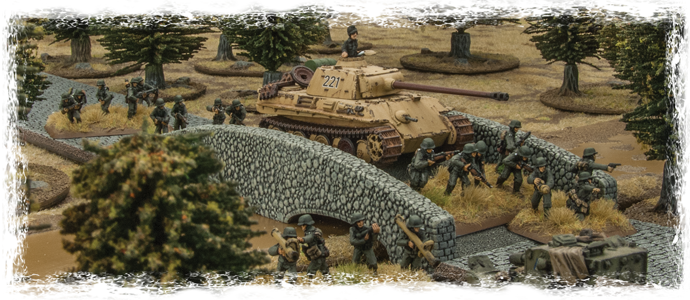 |
1st Marine Grenadier Division
|
|
This list represents a company of 1st Marine Grenadier Division during the fighting on the Oder in April 1945, where they attempted to repulse Soviet attempts to cross the river and gain a bridgehead. During this period, they were supported by the newly rebuilt 210. Sturmgeschütz-Brigade (210th Assault Gun Brigade), which was equipped with a mixture of StuG IIIs, StuHs and Panzer IV 70s, portrayed in this list by the Panzer Battlegroup formation.
|
|
On the table, this force would primarily rely on its infantry and HMG nests to hold objectives, whilst the assault guns tackle enemy armour, with the StuHs offering extra flexibility with their ability to bombard enemy positions. If you prefer a more aggressive force, you could switch out the Nests and StuHs for another Platoon of StuGs, which would be more capable when tackling enemy armour. The 12.2cm captured howitzers could be switched out for a unit of 10.5cm guns depending on personal preference.
|
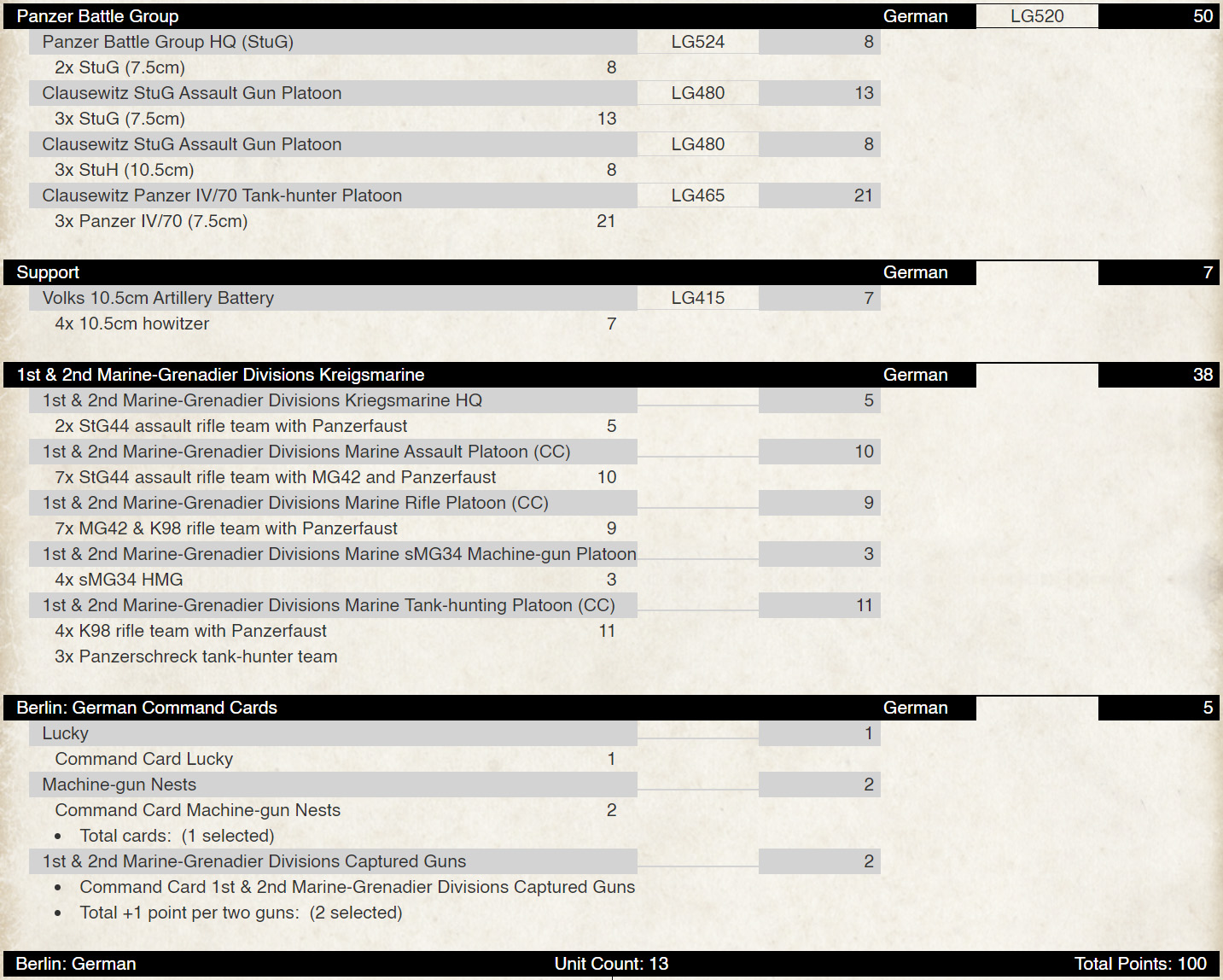 |
2nd Marine-Grenadier Division
|
|
This list represents an infantry company from 2nd Marine Division, supported by the AA guns of 122. Flakregiment during the fighting for the Weser and Aller rivers in early April 1945. The Allied Hungarian Rifle Platoon represents one of the platoons from either Hungarian Artillery Training Battalion 7 or Hungarian Battalion Kotolay, which were pressed into service alongside the Division. Finally, the two tigers are from Kampfgruppe Grosnan, which was formed from a training school in their area. I haven’t included any artillery heavier than mortars in this list as the 2nd Division initially lacked artillery because its assigned artillery regiment was unable to move due to a lack of horses to pull its guns.
|
|
This is a particularly defensive force and would definitely rely on the 8.8cm railway cars to provide most of its defensive firepower, with 8 AT 14 Shots able to threaten most tanks. Their ability to always deploy from ambush will also keep your opponent guessing, enabling you to react to their deployment. The Tigers serve as a potent mobile reserve, able to deal with Tanks and infantry alike, though they will be hampered by their poor skill and will need to be supported by your Marines.
|
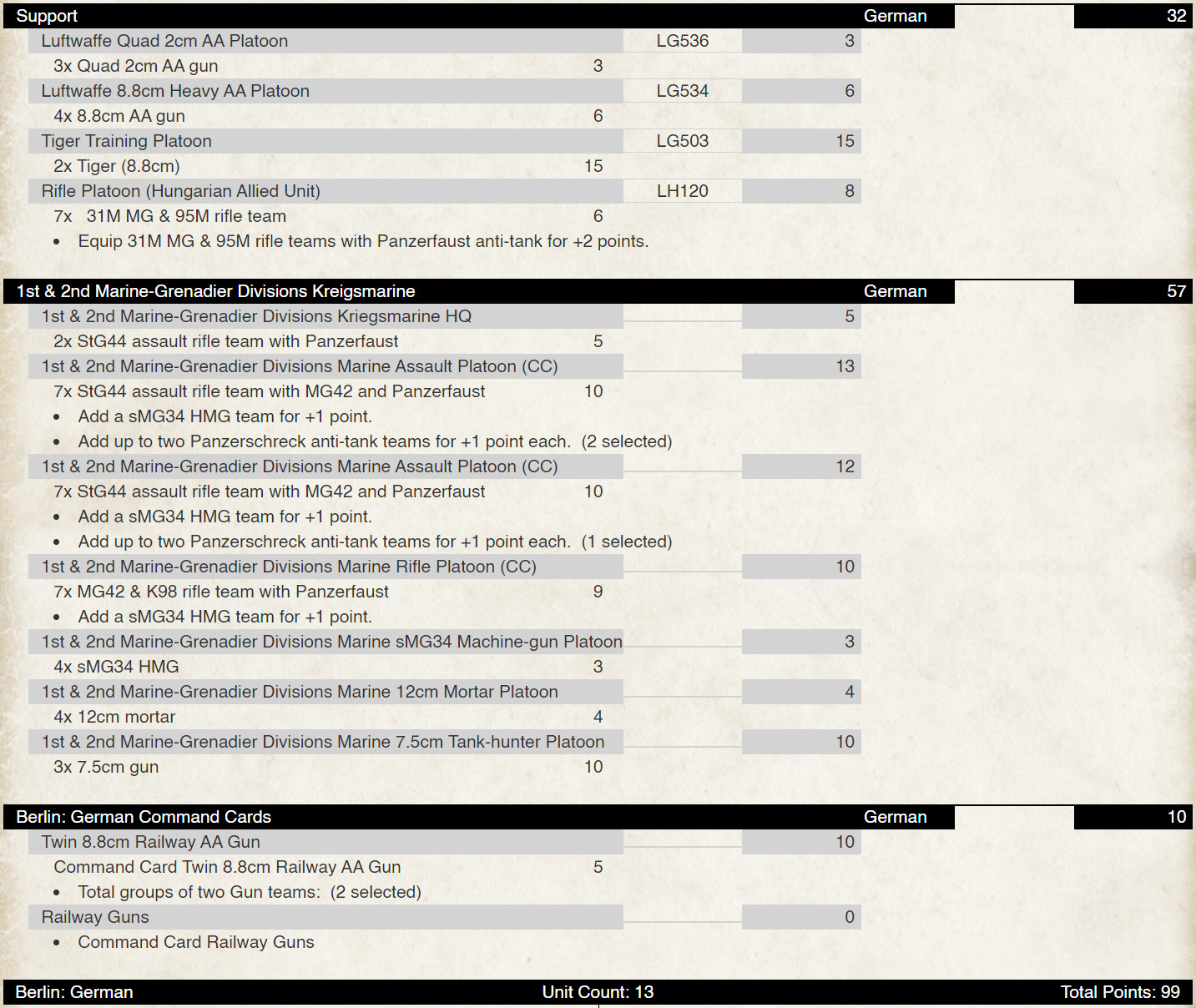 |
|
I hope you’ve enjoyed this article and that these lists might have given you an idea for a force of your own, whether building a new army or fielding your existing Volkgrenadiers as some of the Kriegsmarine’s finest.
~ Ryan
|
|
|